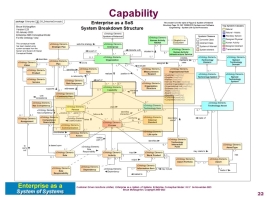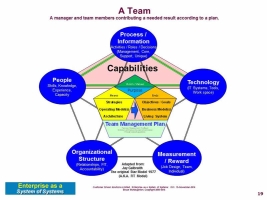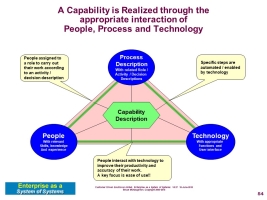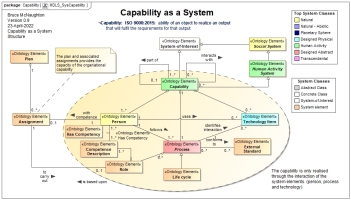Name: Capability
Based on: Human Activity System (HAS)
There are various definitions of capabilities:
- ISO 9000:2015: ability of an object to realize an output that will fulfil the requirements for that output
- TOGAF 9.1: An ability that an organization, person, or system possesses. Capabilities are typically expressed in general and high-level terms and typically require a combination of organization, people, processes, and technology to achieve.
- DoDAF 2.0: The ability to achieve a Desired Effect under specified (performance) standards and conditions through combinations of ways and means (activities and resources) to perform a set of activities.
Also known as:
-
Organizational Capability.
-
Core Capability.
A Capability creates an ability needed by a one or more organizations or teams to contribute to the performance of the enterprise. The capability has the following additional characteristics:
- There is a single definition of a Capability across the Organization based upon a single process description.
- A Capability can be replicated in any number of teams through various process roles assigned to people.
- A Capability has a life cycle for its evolution and improvement.
- There is an owner of the Capability within the Organization
- Competency frameworks identify the skills, knowledge and experience necessary to use a process within a Capability
- Technology is integrated into a capability and is fit for purpose for people to use.
- The set of capabilities realized within an organization are shown on the capabilities dimension of an operating model.
The Capability relates directly to the work performed within an enterprise. This focus on the work also allows for the effectiveness and efficiency of the ability to be understood and improved.
System Quantity Properties
-
Number of organizations realizing the capability
-
Number of people with appropriate skills, knowledge and experience for the capability (underlying process).
Systemic Measurable Variables
The performance of the Capability is created through the interaction of people, process and technology. Each process identifies the performance variables and measurements. Typical systemic variables are:
- Performance variables related to efficiency and effectiveness of carrying out the activities
- Quantity and quality of the results of carrying out the work described in the process.
- Quantify and quality of the match of the skills, knowledge and experience of the practitioners carrying out the work.
-
quantity of work performed
-
the productivity of the people carrying out the work
-
and the quality of the work, outputs and outcomes based upon intended use.
Systemic Capabilities or Functions
A specific Capability is delivered according to a specific process objectives for the capability.. A specific named Capability delivers the specified ability to the Organization.. The ability is realized through the interaction of the people, process and technology.
The desired results are defined in process description.
System States
A Capability can be in various states as defined by the Capability Innovation Life Cycle:
- Architectural states
- Identified: The name of the capability is identified
- Defined: The capability description is complete. The definition is independent of the realization.
- Transformational States
- Potential: All of the elements of a capability (competency of people, process description and technology) are ready to deploy.
- Future: The desired state of the capability in the future (at a point in time).
- Operational States
- Actual: An actual realized capability that is in use
- Current: The state of the capability today (at a point in time).
Capability Owners and Managers or Process Owners and Managers
- Do I have sufficient practitioner involvement in the creation and maintenance of the Capability?
- Do I have the tools and commitment to replicate the capability across the Organization?
- Is this Capability efficient and effective?
- Are changes and improvements to the Capability managed through practitioner feedback and delivered in a when needed?
- Is the capacity of the capability sufficient to achieve the organizational objectives?
Person (also called a practitioner or capability practitioner) taking on the roles and carrying out the work:
- Do I have the skills knowledge and experience to carry out the work?
- Are the activities easy to understand and carry out?
- Is the technology fit for purpose?
Team Manager
- Will this capability help us meet our objectives and purpose?
- How do I improve this capability?
A Capability is an essential system element of an organization or team. See the context of this system.
Capabilities are identified for use within an organization according to a management plan. A capability becomes an integral part of a team.
One or more Organization may be needed to deliver a Capability. This collaboration across teams is defined in the process description for the capability. The roles defined in the process allow various teams to be involved realizing the capability.
The Capability may also interact with teams in the environment outside of the enterprise. This type of interaction must be included in the definition of the capability and how changes to this capability are made.
System Element: Identification
The following picture highlights the structure of a capability:
Three elements form the parts of a capability.
- People (See System Element: People)
- Process (See System: Process)
- Technology Item (See System Element: Technology Item)
System Element: Relationships
The following picture shows the interaction of the system elements.
Each Capability is realized through the interaction of people, process and technology. Each interaction is described below:
- People <--> Process: A person takes on a role and associated responsibilities to carry out an activity.
- Process <--> Technology: A Technology Interaction Point identifies where technology automates the process.
- People <--> Technology: The technology improves the effectiveness and efficiency of the person. The appropriate human factors have been considered.
NOTE: The interactions within a capability are very important. The two key aspects of the capability are shown in the following picture:
The People <--> Process interaction forms a Human Activity System (HAS). This Human Activity System must be understood and if possible implemented prior to establishing the technology.
Once the human activity system is understood, the Process <--> Technology interface uses Technology Interaction Points identified within the process activities where technology can effectively automate steps in the process. Human factors are also considered in the People <--> Technology interface. The result is a sociotechnical capability.
Configuration / Scenario:
Describes any configuration / scenario attributes for a specific system-of-interest. This may not be appropriate for all system descriptions (e.g. patterns or abstract systems).
Cyclical (Repeating / Regular) Processes
Once a capability has been designed and developed, the team managers will create, use and release the capabilities as necessary.
The manager of a team / organization identifies, manages, uses, improves, and releases the relevant parts of capabilities necessary to achieve the objectives of the team using the Team Performance Management Process.
Capabilities can be replicated across the organization through the allocation of people with the appropriate skills, knowledge and experience and the associated technology. These capabilities use a single process description. within the organizational set of processes.
The quality of the realization of the Capability is dependent upon the selection of people to carry out the process and the technology available to support the capability.
The capacity of the capability can be changed by the team manager in order to meet their team objectives.
Development Life Cycle Processes
Changes or enhancements to the Capability can be made at the time the capability is designed. These changes are typically made by a Capability Innovation Team allocated to manage the capability.
This team focuses on the three elements and their interaction as a whole:
- People: Changes to the people element of a capability can be handled through the following:
- Recruitment / Selection criteria improvements, (e.g. Job descriptions, skill profiles, interview questions, etc)
- Development of skills, knowledge and experience from within; improved training approach
- Increasing the planned capacity of the team identified in the plan (e.g. additional people, technology, etc)
- See Develop People
- Process: Review of the process and its effectiveness following realization. The following questions can be asked:
- Does the process meet its objectives?
- Is there waste in the process that can be eliminated?
- Are procedures required to ensure a repeatable process is used?
- The Capability Innovation Life Cycle is used to make these changes.
- Technology: The following questions can be asked related to technology that supports the people and process
- Are the Technology Interaction Point identified and defined?
- Will changes to the technology demonstrate improved performance or quality?
- Will the improvements be timely?
- Technology will be improved through the appropriate life cycle for developing / changing the technology part. In the case of IT, Information Systems Innovation Life Cycle is used to make these changes. Capabilities may also be used to create new technology which may also be part of the technology used in a capability (e.g. making parts for products).
Capabilities can be acquired externally and would be changed through a contract and service level agreements.
The following references support this type of system-of-interest.
Book References
Competitive Advantage, Michael E. Porter
Wellsprings of Knowledge, Dorothy Leonard
Organization Design, Jay Galbraith
Concerns




